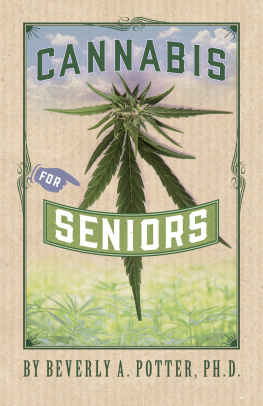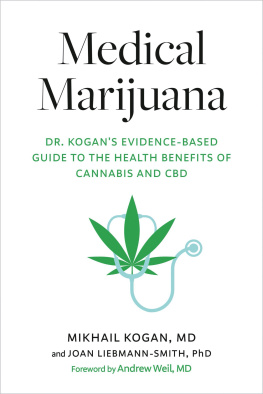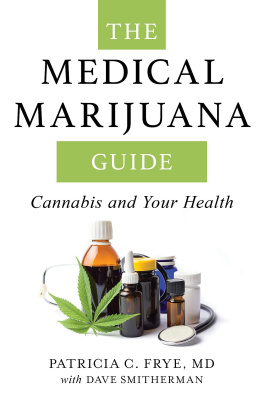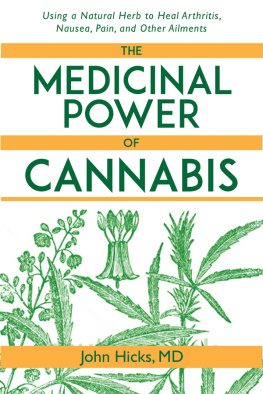Cannabis Pharmacy
The Practical Guide to Medical Marijuana
Michael Backes
FOREWORD BY ANDREW WEIL, M.D.
Text copyright Michael Backes, 2014
Design and illustrations copyright
Elephant Book Company Limited, 2014
This Black Dog & Leventhal Publishers, Inc. edition is published by arrangement with Elephant Book Company Limited and Michael Backes.
Black Dog & Leventhal Publishers, Inc.
151 West 19th Street
New York, NY 10011
Elephant Book Company Limited,
35, Fournier Street,
London E1 6QE
United Kingdom
Distributed by
Workman Publishing Company
225 Varick Street
New York, NY 10014
Editorial Director: Will Steeds
Managing Editor: Laura Ward
Project Editor: Anna Southgate
Index: Christine Shuttleworth
Art Editor: Louise Turpin
Illustrations: Robert Littleford
Cover illustration: Louise Turpin
ISBN 13: 978-1-57912-951-4
eISBN: 978-1-60376-334-9
Library of Congress Cataloging-in-Publication Data available on file
All rights reserved. No part of this book may be reproduced in any form, except brief excerpts for the purpose of review, without the written permission of Black Dog & Leventhal Publishers, Inc. The illustrations may not be reproduced, stored in retrieval systems, or transmitted in any form or by any means, electronic, mechanical, photocopying, recording, or otherwise, without prior written permission from Black Dog & Leventhal Publishers, Inc. and Elephant Book Company Ltd.
DISCLAIMER
The cultivation, possession, use, and supply of cannabis are criminal offenses in most states, and in many countries, punishable by fine and/or imprisonment. This book is not intended to advocate or recommend the unlawful use of cannabis for any reason. It is based on the authors research into existing scientific and anecdotal information concerning the use of cannabis for medical purposes, and is not intended to provide guidance or prescription for self-medication or for any particular course of treatment incorporating cannabis, which should only be pursued under the care of a physician in states where such use is permitted by law.
Contents
Foreword by Andrew Weil, M.D.
From the perspective of someone who has studied traditional therapies as a career, it is surprising that cannabis ever left our medicine cabinets, since the plant has been used for millennia in cultures throughout the world as a curative for ailments of both mind and body. In 1942, the American Medical Association (AMA) fought to keep it as part of the U.S. Pharmacopeia. In spite of the long history of cannabis as a safe and effective treatment for many conditions, the AMA lost that battle, and cannabis was banned. Now, more than seventy years later, the American Herbal Pharmacopeia has begun publishing a two-part monograph on cannabis, returning the plant and its derivatives to their proper places as useful medicines.
During its long exile, cannabis was falsely characterized as a dangerous narcotic, though the reality of its medicinal value was known by many. Patients undergoing treatment for HIV shared that cannabis increased appetite. Multiple sclerosis patients reported that cannabis relieved stiffness and pain. And a few cancer patients for whom allopathic treatments failed, found that cannabis could occasionally help the body overcome drug-resistant tumors. The medical and research communities are only just beginning to discover and investigate what their patients have known for decades.
Michael Backes excellent overview combines current research with real world observations from the patients utilizing cannabis dispensaries in California to present compelling evidence about the medical conditions for which the plant can often provide effective treatment. Intended as a guide for patients and their physicians, the book explains what has been recently learned and what has been rediscovered about the uses of the cannabis plant as a medicine. I have often said that Western medicine could benefit from using traditional plant remedies instead of, or in combination with, the synthetic drugs that dominate the modern pharmacopeia. I would also say that cannabis is one of the best examples of a safe and effective botanical remedy that is underutilized and still largely misunderstood by many conventional practitioners.
Owing to variations in their chemistry, different cultivated varieties of cannabis produce different physiologic effects, and sometimes widely different experiences, yet there is little evidence-based guidance about using particular cannabis varieties to address specific conditions or symptoms. This book helps fill that gap.
Clinical investigation is confirming that many common Western diseases such as diabetes and cancer may be closely linked to metabolic dysfunction caused by poor diet and inactivity. We are also beginning to see evidence that cannabis contains potent homeostatic regulators that can help balance and maintain metabolism. Its chemical constituents interact with the bodys own endocannabinoid system, affecting every physiological process, including appetite, regulation of mood, and perception of pain.
My journey in developing integrative approaches to health and wellness began with a strong emphasis on mind-body interactions, and when I began studying cannabis in 1968, in my senior year at Harvard Medical School, I learned that it is capable of producing an extraordinary range of effects. This work was conducted two decades before the endocannabinoid system was discovered. Since that time, science has continued to confirm what experience has told us for centuries. With the evidence presented in this informative guide, the value and utility of cannabis as medicine becomes even clearer.
It is my strong hope that the work of Michael Backes and other like-minded professionals will inspire further rational and scientific approaches to cannabis, steer us away from the political agenda that has made it difficult for patients to access the benefits of this useful plant, and guide the medical community to use it intelligently.
Introduction
When we consider the arguments against the use of cannabis as a medicine, we must first look at the evidence. What we know is that cannabis is certainly not a panacea, but for specific individuals and circumstances, it is very useful and quite safe. Both advocates and detractors of medical cannabis continue to promote a somewhat shocking range of misconceptions about medical cannabis. Cannabis wont cure every cancer; it does produce side effects; and it is not right for everyone. Before the publication of this book, finding evidence-based information about herbal cannabis medicines often proved challenging. I wrote this book primarily because I needed information on the history of medical cannabis, how to use it appropriately, and the varieties and conditions it has successfully treated for my work in California with patients using cannabis under a physicians supervision. But with only 21 U.S. states permitting the medical use of cannabis in late 2013, I recognize that there are many seriously ill individuals who must rely on illicit sources for cannabis, and these patients have an acute need for accessible and informed guidance. This book is not intended to replace professional medical advice and supervision. Anyone comtemplating using cannabis as a medicine should seek advice from a doctor.










